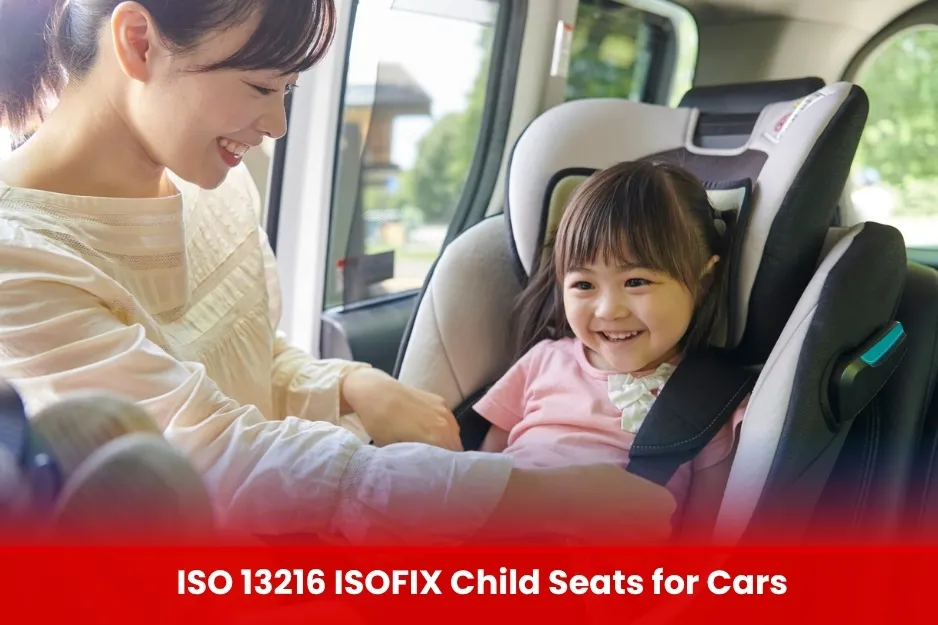SO 13216 ISOFIX Child Seats for Cars
ISO 13216 is an international standard developed by the International Organization for Standardization (ISO) that defines the design and installation requirements for ISOFIX, a standardized system used to secure child safety seats in vehicles.
The main goal of ISOFIX is to provide a safer, easier, and more reliable method for installing child car seats, reducing the risk of incorrect installation compared to traditional seatbelt methods.

Aim of ISO 13216 ISOFIX Child Seats for Cars
Establish a standardized, safe, and user-friendly anchoring system (ISOFIX) for installing child restraint systems (CRS) in vehicles, thereby reducing misuse and improving child passenger safety.
Course Overview
SO 13216 ISOFIX Child Seats for Cars
Total Modules 6
Training Credits 12
Directed Learning Hours (DLH) 90
Course Code BUK1937
- Automotive Engineers & Designers
Those involved in vehicle design, especially seating systems and safety integration. - Child Car Seat Manufacturers
Product developers, designers, and quality assurance teams involved in CRS (child restraint systems). - Vehicle Manufacturers / OEMs
Professionals in production, design, and testing of passenger vehicles. - Safety & Compliance Officers
Those responsible for ensuring product compliance with international safety standards. - Testing Laboratories
Engineers and technicians involved in vehicle safety testing and crash simulations. - Government Regulators & Inspectors
Transport safety authorities, road safety auditors, and standard enforcement personnel. - Academicians / Trainers
Educators and researchers in automotive safety or child passenger protection.
| Course Code | Curriculum Title | Credit | DLH |
|---|---|---|---|
| BUK1937-1 | Introduction to ISO 13216 & ISOFIX | 3 | 15 |
| BUK1937-2 | Structure of ISO 13216 Standard | 3 | 15 |
| BUK1937-3 | ISOFIX System Components & Design | 3 | 15 |
| BUK1937-4 | Installation and Compatibility | 3 | 15 |
| BUK1937-5 | Testing & Performance Requirements | 3 | 15 |
| BUK1937-6 | Compliance, Certification & Regulation | 3 | 15 |
Module 1: Introduction to ISO 13216 & ISOFIX
- Overview of ISO 13216 standard
- Evolution of child restraint systems in vehicles
- Importance of ISOFIX in child safety
- Differences between ISOFIX and traditional seatbelt systems
Module 2: Structure of ISO 13216 Standard
- Key parts of the standard (e.g., ISO 13216-1, ISO 13216-2)
- Definitions and terminology
- Scope and application areas
- Relationship with other automotive safety standards (e.g., UNECE R44, R129)
Module 3: ISOFIX System Components & Design
- Vehicle anchor points: lower anchors and top tether
- Types of ISOFIX seats: Universal, Semi-universal, Specific vehicle
- CRS (Child Restraint Systems) design considerations
- Safety mechanisms and connectors
Module 4: Installation and Compatibility
- ISOFIX installation methods and guidelines
- Common errors in installation
- Compatibility between CRS and vehicles
- Use of ISOFIX guides, indicators, and support legs
Module 5: Testing & Performance Requirements
- Crash testing and dynamic test procedures
- Load path analysis and stress points
- Material and durability requirements
- Key safety benchmarks under ISO 13216
Module 6: Compliance, Certification & Regulation
- Global regulations referencing ISO 13216
- Vehicle and CRS manufacturer responsibilities
- Marking and labeling requirements
- Documentation for compliance and audit
Module 7: Future Trends and Innovations
- i-Size / R129 integration and ISOFIX evolution
- Smart CRS systems (sensors, alerts)
- Advances in material science and crash safety
- Challenges in emerging markets and mobility solutions
- Automotive Industry Professionals
- Child Restraint System (CRS) Manufacturers
- Vehicle Safety & Testing Experts
- Regulatory & Government Bodies
- Academics, Trainers & Researchers
- All Modules within this qualification are assessed internally by the approved training Centre and externally verified by BURRAQ UK. The program uses a criterion-referenced assessment approach to ensure that learners successfully meet all required learning outcomes.
- A Pass in any unit is granted only when the learner submits valid, reliable, and authentic evidence that demonstrates achievement of the assessment criteria. The Assessor is responsible for reviewing this evidence and confirming that the learner has attained the expected standard.
